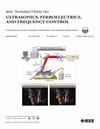Combining Deep Data-Driven and Physics-Inspired Learning for Shear Wave Speed Estimation in Ultrasound Elastography
IF 3.7
2区 工程技术
Q1 ACOUSTICS
IEEE transactions on ultrasonics, ferroelectrics, and frequency control
Pub Date : 2025-04-16
DOI:10.1109/TUFFC.2025.3561599
引用次数: 0
Abstract
The shear wave elastography (SWE) provides quantitative markers for tissue characterization by measuring the shear wave speed (SWS), which reflects tissue stiffness. SWE uses an acoustic radiation force pulse sequence to generate shear waves that propagate laterally through tissue with transient displacements. These waves travel perpendicular to the applied force, and their displacements are tracked using high-frame-rate ultrasound. Estimating the SWS map involves two main steps: speckle tracking and SWS estimation. Speckle tracking calculates particle velocity by measuring RF/IQ data displacement between adjacent firings, while SWS estimation methods typically compare particle velocity profiles of samples that are laterally a few millimeters apart. Deep learning (DL) methods have gained attention for SWS estimation, often relying on supervised training using simulated data. However, these methods may struggle with real-world data, which can differ significantly from the simulated training data, potentially leading to artifacts in the estimated SWS map. To address this challenge, we propose a physics-inspired learning approach that utilizes real data without known SWS values. Our method employs an adaptive unsupervised loss function, allowing the network to train with the real noisy data to minimize the artifacts and improve the robustness. We validate our approach using experimental phantom data and in vivo liver data from two human subjects, demonstrating enhanced accuracy and reliability in SWS estimation compared with conventional and supervised methods. This hybrid approach leverages the strengths of both data-driven and physics-inspired learning, offering a promising solution for more accurate and robust SWS mapping in clinical applications.结合深度数据驱动和物理启发学习超声弹性成像中横波速度估计。
横波弹性成像(SWE)通过测量反映组织刚度的横波速度(SWS),为组织表征提供定量标记。SWE使用声辐射力脉冲序列来产生横波,横波通过具有瞬态位移的组织横向传播。这些波垂直于施加的力传播,它们的位移是用高帧率超声波跟踪的。估计SWS图包括两个主要步骤:斑点跟踪和SWS估计。散斑跟踪通过测量相邻发射之间的RF/IQ数据位移来计算粒子速度,而SWS估计方法通常比较横向相距几毫米的样品的粒子速度分布。深度学习(DL)方法已经引起了人们对SWS估计的关注,通常依赖于使用模拟数据的监督训练。然而,这些方法可能会与真实世界的数据作斗争,这些数据可能与模拟的训练数据有很大的不同,这可能会导致估计的SWS图中的伪影。为了应对这一挑战,我们提出了一种物理启发的学习方法,该方法利用真实数据而不知道SWS值。我们的方法采用自适应无监督损失函数,允许网络使用真实的噪声数据进行训练,以最小化伪像并提高鲁棒性。我们使用实验幻影数据和来自两名人类受试者的体内肝脏数据验证了我们的方法,证明与传统和监督方法相比,SWS估计的准确性和可靠性更高。这种混合方法利用了数据驱动和物理启发学习的优势,为临床应用中更准确、更强大的SWS制图提供了一种有前途的解决方案。
本文章由计算机程序翻译,如有差异,请以英文原文为准。
求助全文
约1分钟内获得全文
求助全文
来源期刊
CiteScore
7.70
自引率
16.70%
发文量
583
审稿时长
4.5 months
期刊介绍:
IEEE Transactions on Ultrasonics, Ferroelectrics and Frequency Control includes the theory, technology, materials, and applications relating to: (1) the generation, transmission, and detection of ultrasonic waves and related phenomena; (2) medical ultrasound, including hyperthermia, bioeffects, tissue characterization and imaging; (3) ferroelectric, piezoelectric, and piezomagnetic materials, including crystals, polycrystalline solids, films, polymers, and composites; (4) frequency control, timing and time distribution, including crystal oscillators and other means of classical frequency control, and atomic, molecular and laser frequency control standards. Areas of interest range from fundamental studies to the design and/or applications of devices and systems.

 求助内容:
求助内容: 应助结果提醒方式:
应助结果提醒方式:


